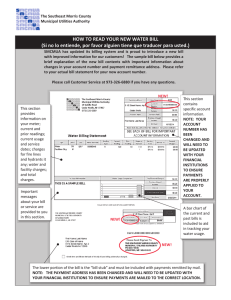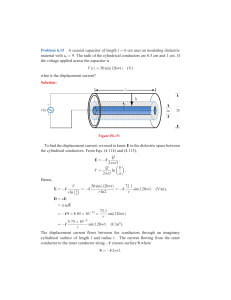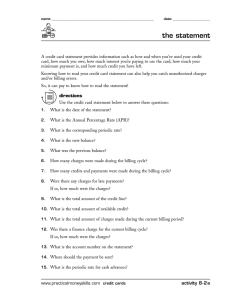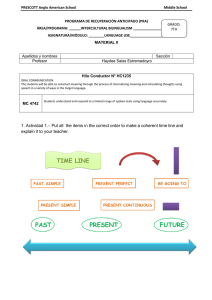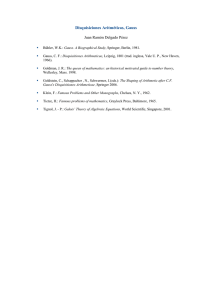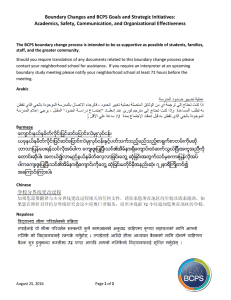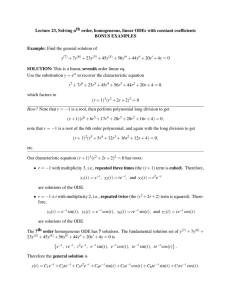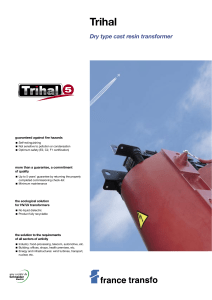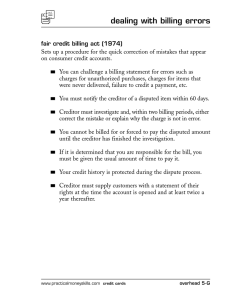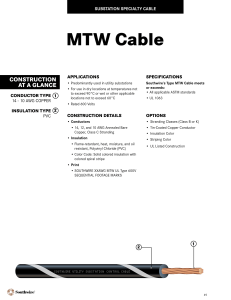Subido por
1401920001 ISMAEL GONZALEZ RAMIREZ ESTUDIANTE ACTIVO
Jackson 4 10 Homework Solution
Anuncio
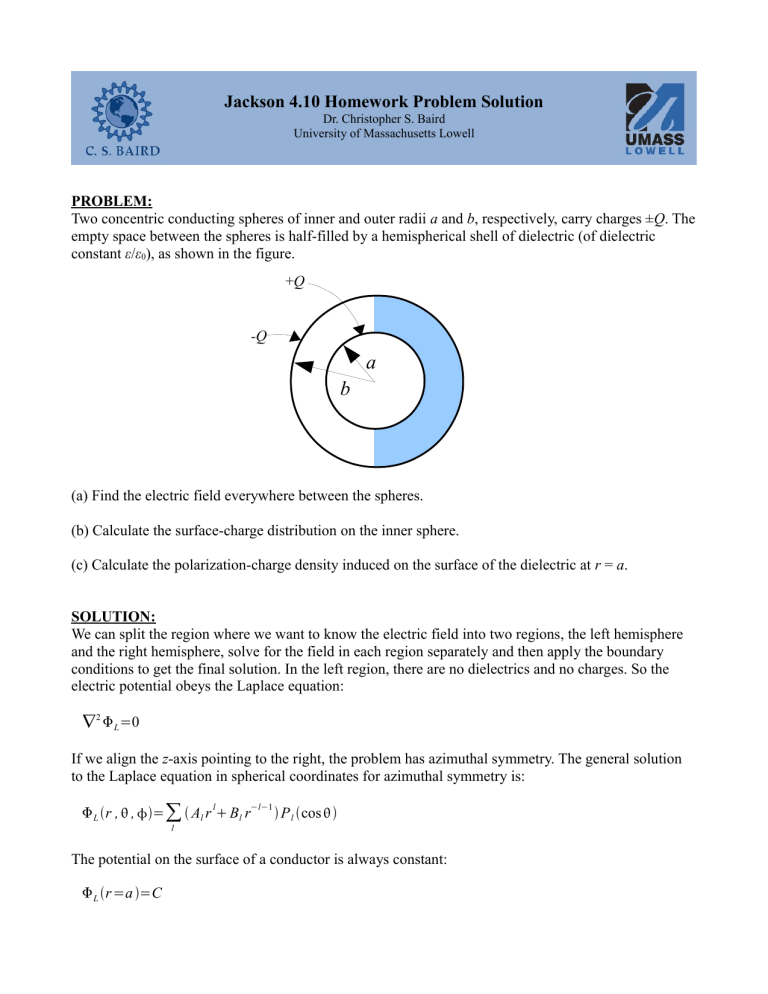
Jackson 4.10 Homework Problem Solution Dr. Christopher S. Baird University of Massachusetts Lowell PROBLEM: Two concentric conducting spheres of inner and outer radii a and b, respectively, carry charges ±Q. The empty space between the spheres is half-filled by a hemispherical shell of dielectric (of dielectric constant ε/ε0), as shown in the figure. +Q -Q a b (a) Find the electric field everywhere between the spheres. (b) Calculate the surface-charge distribution on the inner sphere. (c) Calculate the polarization-charge density induced on the surface of the dielectric at r = a. SOLUTION: We can split the region where we want to know the electric field into two regions, the left hemisphere and the right hemisphere, solve for the field in each region separately and then apply the boundary conditions to get the final solution. In the left region, there are no dielectrics and no charges. So the electric potential obeys the Laplace equation: ∇ 2 L =0 If we align the z-axis pointing to the right, the problem has azimuthal symmetry. The general solution to the Laplace equation in spherical coordinates for azimuthal symmetry is: l L r , , =∑ Al r Bl r −l−1 P l cos l The potential on the surface of a conductor is always constant: L r =a =C C=∑ Al a l Bl a −l −1 Pl cos l Because this equation must hold for all values of the independent polar variable and because the Legendre polynomials are orthogonal, all coefficients must equate independently: C= A0 B0 and a Bl =−Al a 2l 1 for l > 0 This solution now becomes (the arbitrary constant C does not contain any new information, so we leave l = 0 constants as is): ∞ B L r , ,=A0 0 ∑ Al r l =1 l r a − a r l1 P l cos The other surface is also a conductor and must have a constant potential as well: L r =b=D D=A0 B0 ∞ ∑ A b l =1 l l b a − a b l 1 P l cos Because this equation must hold for all values of the independent polar variable and because the Legendre polynomials are orthogonal, all coefficients must equate independently. Al must be zero for all l > 1. This leaves the potential: L r , ,=A0 B0 r This leads to a total electric field of: E L= B0 r2 r We could have guessed this form of the solution based on the symmetry of the problem, but it is often safer and more instructive to go through all the steps. The right hemisphere is a separate region and can be now solved separately. In the region between the shells, we can tell that there are no free charges and no bound charges (the bound charges, or polarization charges, will reside along boundaries, but not in the volume where we want to know the potential). The total electric potential then obeys the Laplace equation: 2 ∇ R=0 The same process as above is applied leading to the same form of the solution: E R= C0 r r2 We can now apply boundary conditions where the dielectric material meets free space. The tangent component of the electric field must be continuous across the boundary: E L × =ER× [E L⋅r =E R⋅r ]= /2 B0 r 2 = C0 r2 B0 =C 0 which leads to: E R=EL = B0 r 2 r Because all materials are linear, this directly tells us that D L = 0 B0 r2 r and D R= B0 r2 r Because the free charges give rise to the D field, the fact that D on the left is different from D on the right means that the free charge densities on each side must be different. The last fact that we know is that there is a total free charge Q on the inner conductor surface and a total free charge -Q on the outer conductor surface. We only know the total free charge, not the free charge density. We cannot assume the free charge spreads out uniformly over the sphere, because there is nothing in the problem to suggest that. Because we don't know the charge density, we cannot use a local boundary condition, but instead an integrated boundary condition that makes use of the total charge. We draw an integration sphere with radius r where a < r < b so that it completely encloses the free charge Q and use Gauss's law in integral form. We could use Gauss's law for the E, D, or P fields. We only know the total free charge, which only gives rise to the D field, so we use: ∮S D⋅r d 3 x=Q We must be careful here. We found above that the D field is not the same over this integration sphere, so we must split the integral into two pieces: 2 /2 2 ∫ ∫ DR⋅r r 2 sin d d ∫ ∫ D L⋅r r 2 sin d d =Q 0 0 0 / 2 2 /2 2 B 0 ∫ ∫ sin d d 0 B0 ∫ ∫ sin d d =Q 0 B0 = 0 0 /2 Q 2 0 We now have our final solutions: D L= E= 0 Q 0 2 r 2 r and D R= Q r 0 2 r 2 Q r 0 2 r 2 (b) Calculate the surface-charge distribution on the inner sphere. The distribution of free surface charges σ is linked to the D-field according to: ∇⋅D= We draw a Gaussian pillbox straddling the surface and use the divergence theorem to find: [D2−D1⋅n= ]on S Inside a conductor there are no fields, so D1 = 0. L =[ DL⋅r ]r=a and R=[ DR⋅r ]r=a L= 0 Q 0 2 a 2 r and R= Q r 0 2 a 2 (c) Calculate the polarization-charge density induced on the surface of the dielectric at r = a. We use Gauss's law on a pillbox surface again, but instead only enclose the polarization charge. [P2−P1⋅n=− pol ]on S Inside the conductor there are no fields, so P2 = 0 and the normal now points inwards, n = -r [P⋅r =− pol ]r =a pol =[−P ]r =a For linear materials, we know P=− 0 E pol =[−− 0 E ]r =a pol = 0 −Q 0 2 a 2 Of course, this only applies to the right side. There is no dielectric material on the left side and therefore no polarization charge.
